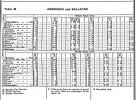O L Leigh
Established Member
The new kid on the block is not a “consultation” as mentioned above by O.L, although that may follow.
The possible game changer may be a consultant’s report into the economics of making 3rd rail safer.
Network Rail who have advertised for consultants to carry out the study made their position clear by saying at the start of the advert that third rail is ten times more dangerous.
That is the consultation to which I was making reference, the advertisement for which kicked off the discussion last year.
Was this retraction published, perchance?
I've seen no retraction so would welcome a lead on this.
Interesting when did they advertise for this service?
It was June of last year. Click.
I'll merely point out that the 1950s battery twin set operated on Aberdeen to Ballater, charging overnight in the bay at Aberdeen with a bit of a boost when turning round there, was 43 miles each way, 86 miles round trip, or 139km. It did three or four round trips a day, to the same timings as the dmu which operated the opposite diagram. The battery industry constantly goes on about how they are advancing, but really things are not that far forward in 60 years.
I don't think there was much on that unit to draw power from the battery, though. The motors, obviously, a few light bulbs, presumably a vacuum pump for the braking system and that would have been about it. Not much more complex than a contemporary milk float, really.
You are correct in all this. The Kentish Town incident a few years ago showed that, for all the modern emergency batteries were rated to a certain spec, on the day they delivered less than half that.
This is quite a hobby-horse of yours, isn't it.
Without wishing to invite further topic drift, the batteries on the units in question were not intended to run hotel power such as A/C, still less move the train, and so were not rated to give that sort of output. A/C is a very high-draw system and the provision of battery power sufficient to keep a packed train cool on a hot day for even a couple of hours off the juice would require quite some additional capacity with it's consequence for cost and weight. And all just to cover off an eventuality that an individual unit may never have to cope with but which would penalise the operator every single day in terms of additional maintenance cost, track access charges and so on.

